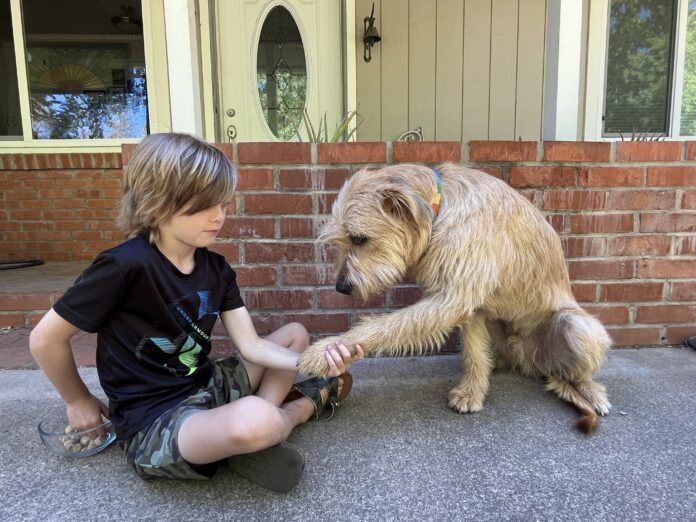
Several training techniques can be used to teach a dog to “Shake hands.” Here are four methods for teaching this amusing trick – capturing, shaping, lure-shaping, and prompting. Different dogs may respond better to one method than another; you should use whichever training method works best for your dog. We will describe which method tends to work best with dogs with different behavioral tendencies. Here’s how to use each of these training techniques to teach your dog to “give a paw” on cue:
“Capture” the Paw Lift
Some dogs are naturally “pawsy,” often using their feet to touch you or objects they are playing with. These are the easiest to teach to shake.If this describes your dog, try this method:
- Just hang out with your dog (it’s best if she’s sitting) and wait for her to lift a paw.
- When she does, “mark” this behavior with the click of a clicker (or other reward marker, such as a “thumbs-up” hand signal or a verbal marker such as “Yes!”) and give her a treat.
- Repeat by marking any lifts of that same paw (chose left or right – but not both!) until your dog realizes she’s getting reinforced for the paw lift, and then add your “Shake” cue just before she lifts her paw. With enough repetitions she’ll offer her paw even every time you cue her to “Shake.”
- Now start offering your hand so she can rest her paw on it for your final shake behavior.

“Shape” the Shake
Shaping shake works well for dogs who move their feet often while otherwise sitting still, but don’t raise a paw high enough to shake. If this describes your dog, try this method:
- Start by having your dog sitting in front of you. The instant you see a tiny movement with either foot, mark the behavior and feed her a treat.
- Now focus on that paw only (if you randomly mark the movement of either paw you may get a shuffle instead of a shake!) and continue to mark and treat for any paw movement.
- As your dog starts to move that foot on purpose in anticipation of reinforcement, very gradually raise the criteria you require in order to mark and treat. For example, only mark-treat if the paw moves at least one inch off the floor. When that happens consistently, raise the criteria to two inches. Continue raising the criteria slowly, add your cue, and you’re off and shaking!

“Lure-Shape” the Shake
If your dog sits perfectly still with no paw movement at all, try this method, lure-shaping the paw lift.
- Hold a treat at the end of her nose and slowly lift it until her nose is pointed almost straight up. Now move the treat slowly to one side so she shifts her weight onto one foot and the other paw lifts slightly. Mark and treat.
- Repeat until the paw lift gets easier and she starts to offer paw movement without the lure, then continue as described in the shaping section, luring if needed while you raise criteria. Fade your lure as quickly as possible so that you can get your “Shake” on verbal cue.

“Prompting” the Paw
If the above-mentioned methods fail, you can prompt your dog to move her paw. We would rarely start teaching a behavior using a physical prompt, as dogs tend to learn best when their freely offered behaviors are marked and rewarded, rather than when they are pressured by a physical touch. However, some dogs are reluctant to offer behaviors (perhaps from being physically punished or intimidated for offering behaviors in the past); these dogs may benefit from a very gentle prompt.
- Start by by lightly tickling or pressing gently on your dog’s pastern (the back of her ankle).
- Mark and treat the moment her paw moves! Good girl!
- Repeat until she starts to offer paw movement as you reach toward her paw – and if she does, don’t follow through with the prompt, but mark and treat for the movement. Then switch to shaping or lure-shaping as described above to get to your final paw-shaking goal.

Paw Targeting
When your dog has learned that moving her paw earns treats, she can teach learn how to do other things with her feet. Teach her to touch her paw to a designated object to ring a bell, turn on a light, push a rolling toy – and these fun behaviors are just the beginning. Have more fun with your dog’s paws!






